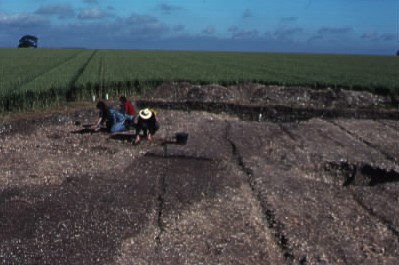
Figure 43: Plough damage at Cottam

A series of regularly-spaced shallow V-shaped grooves ran across each trench at Cottam, aligned NNW-SSE. The grooves were generally placed at intervals of 1.8m across, although there were some instances of double-grooves, and 'dog-legs', and other cases where there was a larger gap. Towards the west edge of COT95 there was a set of short grooves running at right-angles to the main alignment; some of these continued across the full width of the site. The grooves are known to be plough furrows related to an episode of deep ploughing associated with potato planting in 1989. The small perpendicular group in COT95 provides evidence for a small area of cross-ploughing. The fills were generally dark grey brown silty clay loam and were indistinguishable from the overlying ploughsoil, although where the grooves had cut through underlying features they incorporated fill from the surrounding matrix.
A general layer of dark grey brown clay loam, c.0.2-0.3m in depth (1000, 1001, 1080, 3000, 3003, 3022, 4000, 4025, 4176) overlay the excavated areas in each trench. This layer was removed by machine, with shovel cleaning of the residue. Finds were hand-collected, and the spoil was screened by metal-detectors. This layer is twentieth-century ploughsoil, but incorporates material disturbed from earlier features. In particular, it contained a number of residual finds and abundant chalk fragments of varying size which had probably been disturbed from the underlying chalk bedrock by the plough, and were being gradually broken up by frost action. Although finds were gathered by hand collection only, in comparison with ploughsoil from COT93, there was only a small quantity of animal bone recovered from the ploughsoil in COT95.
© Internet Archaeology
URL: http://intarch.ac.uk/journal/issue10/richards/plough.html
Last updated: Tue Apr 24 2001